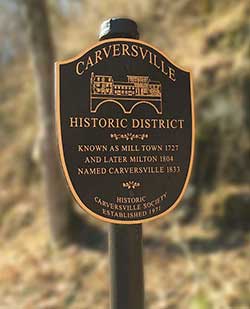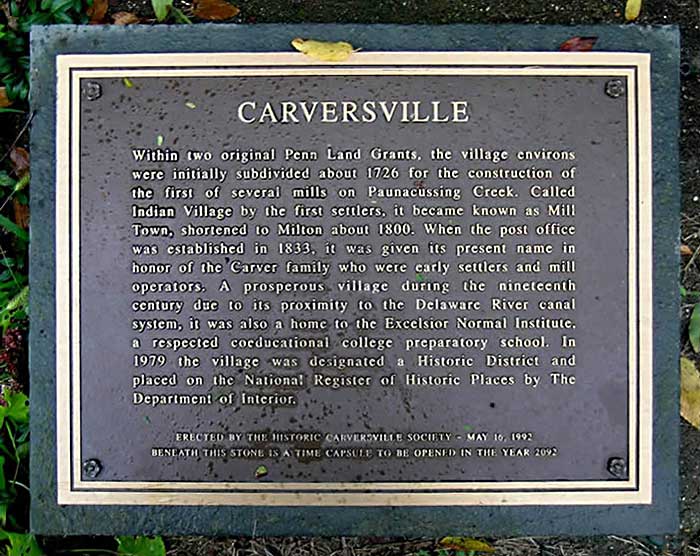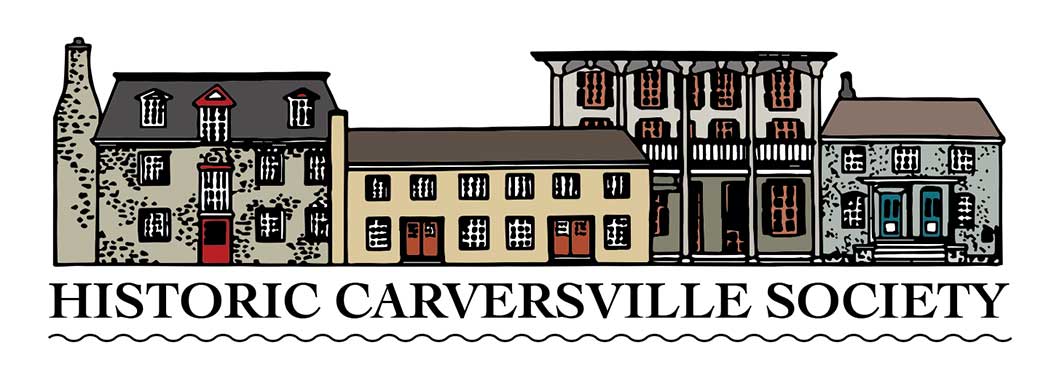
Historic Carversville Society
PO Box 41
Carversville, PA 18913
Sign Up to Hear From Us
events@carversville.org
About Us
The Historic Carversville Society, a volunteer-based non-profit group, dedicated to the future—and past—of this community jewel.
Board of Directors
President: Lori White (2024)
Vice President: Marc Stiefel (2024)
Secretary: Rhonda Heffern (2023)
Treasurer: Laura Viehweger (2024)
Vicki Ghiz (2023)
Elizabeth Gabrielson (2025)
Kathy Tieman Stein (2025)
Sarah Weikert (2023)
Jim Davock (2025)
History
The rural village of Carversville was a Lenni Lenape gathering place which they called Aquetong, or “many springs,” over 300 years ago when William Penn granted tracts to his steward, James Harrison, and to Joseph Pike. Harrison, who never saw the property, deeded his 500 acres to Randall Blackshaw and the Pike tract was divided into four 100-acre parcels.
The village was first surveyed in 1702 after families had begun arriving on horseback. By 1730, roads had been cut into the forests so settlers could haul out wool and farm produce and bring in lumber that was being rafted down the Delaware River from Upper Pennsylvania.
Originally called Indian Village, the town was later named Mill Town, still later Milton and finally, in 1833, Carversville – the name borrowed from the postmaster whose last name was Carver.
A center of commerce from its inception, Carversville boasted such diverse enterprises as Stovers Mill, the Fretz Mill, the Carver Mill, the Suggin Bag manufactory, a sash and blind mill and the famous Roram Hat factory.
In 1859, the Excelsior Normal Institute was founded on the hill overlooking the Village. The five-story stone building became a well-known school which turned out scholars until it fell on hard times in the late 19th Century. Until its demise, students could peer down at the thriving village served by stagecoaches from the railroads at Doylestown and nearby Bulls Island, NJ just three miles away. When the teaching ended, the pleasure began as the building became a resort. Its lifespan, too, was short-lived. The final use for the property was as the Carversville Christian Orphanage. The building was razed in the mid 1900s, but its legacy is intact thanks to the doting research of it present tenant, Edwin “Ned” Harrington, the Village’s official historian.
Small businesses flourished in the Village Square, including two general stores (one of which is occupied by renowned toy expert Noel Barrett today), a creamery, an ice cream parlor, two gas stations, a dance hall, a hotel, a blacksmith, wheelwright, barber, saddler, harness maker, tinsmith, woodworkers and house builders.
Today, the Village still thrives commercially. The General Store, under the loving proprietorship of Hugh Mangum, operates out of the former Carversville Garage, once the stables for the adjacent Carversville Inn. It is the focal point of the community for food, coffee, newspapers, and conversation (i.e., local gossip). The Hotel, now the Carversville Inn, is a popular and well-respected restaurant and local watering hole. Its rooms, however, are now apartments.
The Presbyterian Church, founded in 1872 has disbanded; the building is now a private home. The older Christian Church (1838) still serves the spiritual and social needs of many of the villagers.
There is one antique shop and furniture repair business, a dentist, and a creative design firm doing business today. Artists of many different disciplines pepper the area making Carversville culturally unique.
Carversville is a prime example of a 19th Century farming community and this earned it National Register of Historic Places status from the Department of Interior in 1979. Officially, the Village became “historic.” Carversville was one of the first districts to be so honored and it is now under the protection of federal, state and local laws that regulate changes made to any building which may destroy its historic value.
Time Capsule Plaque

Erected by the Historic Carversville Society on May 16, 1992, this plaque covers a time capsule to be opened in the year of 2092.
